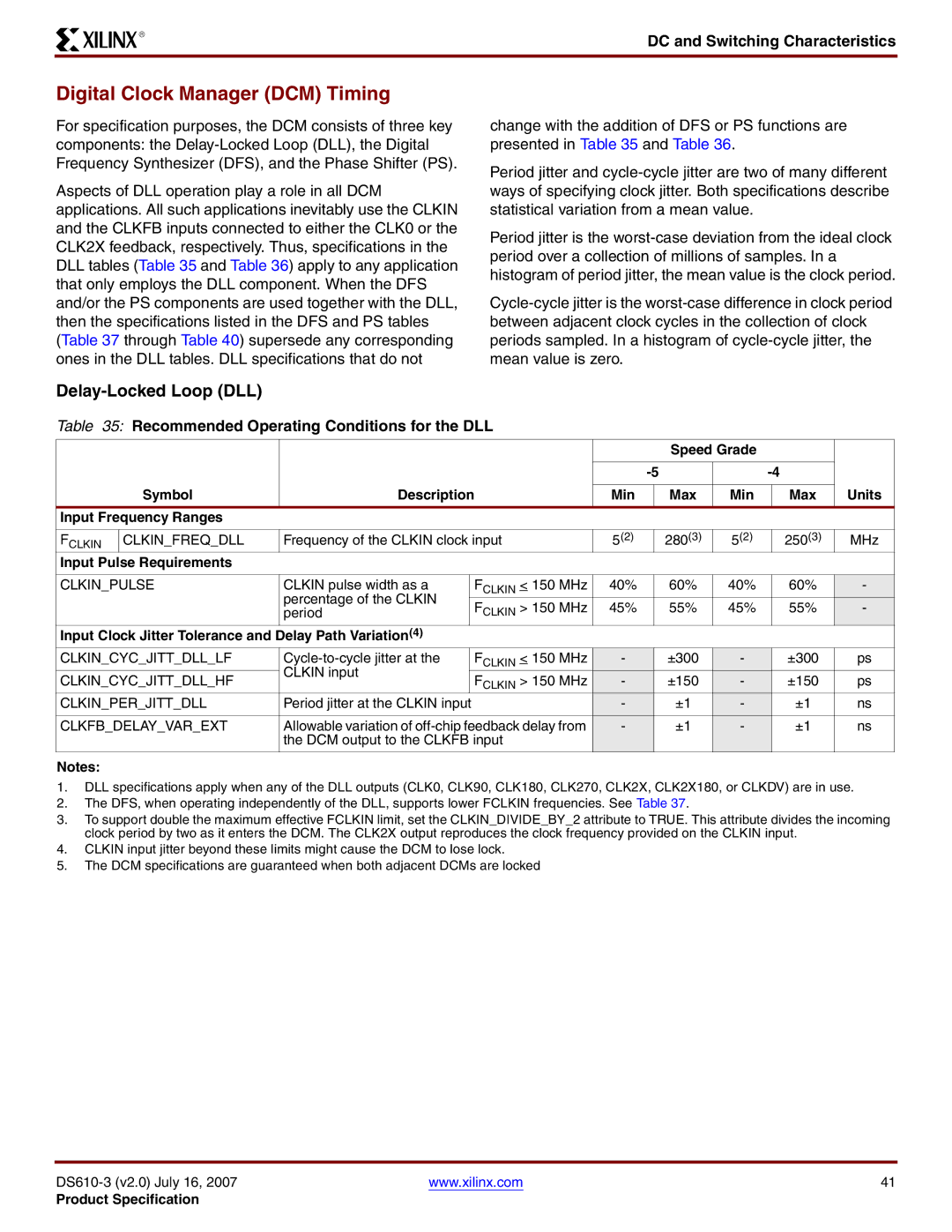
R
DC and Switching Characteristics
Digital Clock Manager (DCM) Timing
For specification purposes, the DCM consists of three key components: the
Aspects of DLL operation play a role in all DCM applications. All such applications inevitably use the CLKIN and the CLKFB inputs connected to either the CLK0 or the CLK2X feedback, respectively. Thus, specifications in the DLL tables (Table 35 and Table 36) apply to any application that only employs the DLL component. When the DFS and/or the PS components are used together with the DLL, then the specifications listed in the DFS and PS tables (Table 37 through Table 40) supersede any corresponding ones in the DLL tables. DLL specifications that do not
change with the addition of DFS or PS functions are presented in Table 35 and Table 36.
Period jitter and
Period jitter is the
Delay-Locked Loop (DLL)
Table 35: Recommended Operating Conditions for the DLL
|
|
|
|
|
|
| Speed Grade |
|
|
| |
|
|
|
|
|
|
|
|
|
|
| |
|
|
|
|
|
|
|
| ||||
|
|
|
|
|
|
|
|
|
| ||
| Symbol | Description | Min |
| Max | Min |
| Max | Units | ||
Input Frequency Ranges |
|
|
|
|
|
|
|
|
|
| |
|
|
|
|
|
|
|
|
|
| ||
FCLKIN | CLKIN_FREQ_DLL | Frequency of the CLKIN clock input | 5(2) |
| 280(3) | 5(2) |
| 250(3) | MHz | ||
Input Pulse Requirements |
|
|
|
|
|
|
|
|
|
| |
|
|
|
|
|
|
|
|
|
|
|
|
CLKIN_PULSE | CLKIN pulse width as a |
| FCLKIN < 150 MHz | 40% |
| 60% | 40% |
| 60% | - | |
|
| percentage of the CLKIN |
| FCLKIN > 150 MHz | 45% |
| 55% | 45% |
| 55% | - |
|
| period |
|
|
| ||||||
Input Clock Jitter Tolerance and | Delay Path Variation(4) |
|
|
|
|
|
|
|
|
| |
CLKIN_CYC_JITT_DLL_LF |
| FCLKIN < 150 MHz | - |
| ±300 | - |
| ±300 | ps | ||
CLKIN_CYC_JITT_DLL_HF | CLKIN input |
| FCLKIN > 150 MHz | - |
| ±150 | - |
| ±150 | ps | |
|
|
|
| ||||||||
CLKIN_PER_JITT_DLL | Period jitter at the CLKIN input |
| - |
| ±1 | - |
| ±1 | ns | ||
CLKFB_DELAY_VAR_EXT | Allowable variation of | - |
| ±1 | - |
| ±1 | ns | |||
|
| the DCM output to the CLKFB input |
|
|
|
|
|
|
| ||
Notes: |
|
|
|
|
|
|
|
|
|
| |
1.DLL specifications apply when any of the DLL outputs (CLK0, CLK90, CLK180, CLK270, CLK2X, CLK2X180, or CLKDV) are in use.
2.The DFS, when operating independently of the DLL, supports lower FCLKIN frequencies. See Table 37.
3.To support double the maximum effective FCLKIN limit, set the CLKIN_DIVIDE_BY_2 attribute to TRUE. This attribute divides the incoming clock period by two as it enters the DCM. The CLK2X output reproduces the clock frequency provided on the CLKIN input.
4.CLKIN input jitter beyond these limits might cause the DCM to lose lock.
5.The DCM specifications are guaranteed when both adjacent DCMs are locked
www.xilinx.com | 41 |
Product Specification
